Embark on an extraordinary journey to the breathtaking realm of scuba diving locations. Dive into a world of vibrant coral reefs, encounter captivating marine life, and unravel the mysteries of shipwrecks and underwater caves. Whether you’re a seasoned diver or a curious novice, discover the factors to consider when selecting your next scuba diving destination, ensuring an unforgettable and safe adventure.
Introduction to Scuba Diving Locations
Scuba diving, short for “self-contained underwater breathing apparatus” diving, is an exhilarating activity that allows individuals to explore the wonders of the underwater world. The allure of scuba diving lies in its ability to immerse oneself in a tranquil and awe-inspiring environment, witnessing marine life and underwater landscapes firsthand.
For those who are looking for an adventure beneath the waves, exploring scuba diving locations around the world can be an unforgettable experience. Whether you’re a seasoned diver or just starting out, there are countless scuba diving locations that offer breathtaking underwater landscapes, diverse marine life, and unforgettable memories.
Selecting the ideal scuba diving location depends on various factors, including the desired experience, level of expertise, budget, and accessibility. Some popular considerations include the clarity of the water, visibility, marine biodiversity, and the presence of underwater features such as coral reefs, shipwrecks, or marine caves.
Factors to Consider When Selecting a Scuba Diving Location
When selecting a scuba diving location, several factors should be taken into account:
- Experience level: Choose a location that aligns with your diving skills and experience. Consider factors such as depth, currents, and visibility.
- Marine biodiversity: Research the types of marine life found at the location. Some destinations are known for specific species, such as manta rays or whale sharks.
- Water clarity and visibility: Clear water enhances the diving experience. Consider factors such as plankton blooms and weather conditions.
- Underwater features: Explore locations with unique underwater features, such as coral reefs, shipwrecks, or marine caves, which offer diverse experiences.
- Budget: Scuba diving can vary in cost depending on factors such as travel expenses, accommodation, and dive operator fees.
- Accessibility: Consider the ease of access to the dive site, including transportation and availability of dive operators.
Top Scuba Diving Destinations: Scuba Diving Locations
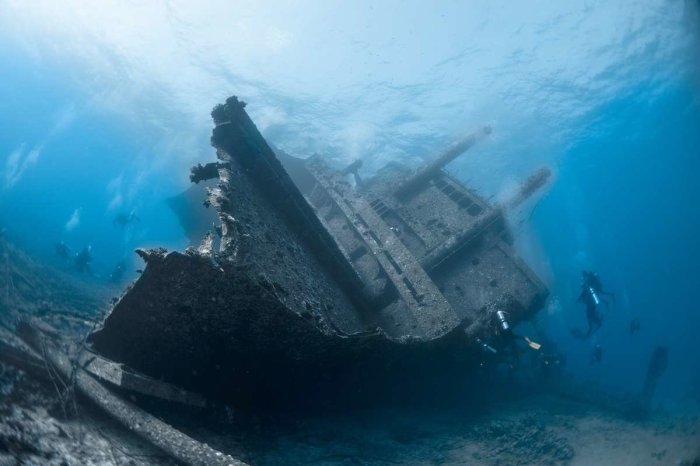
Scuba diving offers a unique opportunity to explore the wonders of the underwater world. There are numerous breathtaking scuba diving destinations around the globe, each with its own distinct features and attractions. Here are some of the most popular destinations for scuba diving enthusiasts:
Popular Scuba Diving Destinations Worldwide
| Destination | Location | Key Features and Attractions | Best Time to Visit |
|---|---|---|---|
| Great Barrier Reef | Australia | Largest coral reef system in the world, home to a vast array of marine life including colorful corals, tropical fish, and marine mammals. | Year-round, but visibility is best from May to September. |
| Maldives | Indian Ocean | Crystal-clear waters, pristine coral reefs, and an abundance of marine life including sharks, rays, and turtles. | Year-round, with the best visibility from December to April. |
| Galapagos Islands | Ecuador | Unique ecosystem with a diverse range of marine life, including sea lions, marine iguanas, and hammerhead sharks. | Year-round, but the best visibility is from June to November. |
| Cozumel | Mexico | World-renowned for its spectacular coral formations, underwater caves, and vibrant marine life. | Year-round, but the best visibility is from May to September. |
Marine Life and Biodiversity
Scuba diving locations offer a glimpse into the diverse and fascinating underwater world, teeming with a myriad of marine life. From vibrant coral reefs to enigmatic shipwrecks, each destination boasts its own unique assemblage of species, creating a captivating symphony of colors, shapes, and behaviors.
Protecting marine ecosystems is crucial for preserving the intricate balance and biodiversity of these underwater realms. Human activities, such as overfishing, pollution, and climate change, pose significant threats to marine life. By promoting sustainable practices, reducing our environmental impact, and establishing marine protected areas, we can safeguard these precious habitats for future generations.
Specific Marine Species and Their Habitats
- Coral Reefs: These vibrant ecosystems are home to a dazzling array of species, including colorful fish, sea turtles, and invertebrates. Coral reefs provide shelter, food, and breeding grounds for countless marine organisms, contributing to the overall health and productivity of the ocean.
- Kelp Forests: These underwater forests, dominated by giant kelp, create a complex and productive ecosystem. Kelp provides habitat for a diverse range of species, including fish, sea urchins, and invertebrates, and plays a vital role in carbon sequestration and nutrient cycling.
- Shipwrecks: These artificial reefs attract a variety of marine life, providing shelter and habitat for fish, invertebrates, and even corals. Shipwrecks often become thriving ecosystems, hosting a diverse community of species that would not otherwise be found in the surrounding area.
Safety Considerations
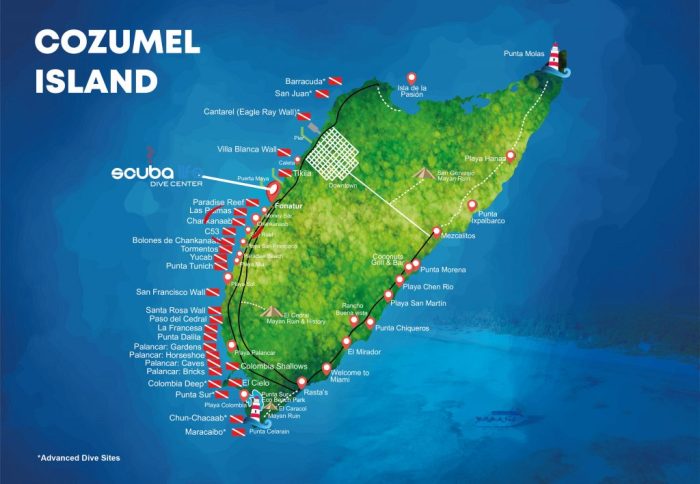
Scuba diving is an exhilarating activity, but it’s crucial to prioritize safety to ensure an enjoyable and incident-free experience. Understanding potential hazards and adhering to safety protocols is paramount.
If you’re looking for an unforgettable adventure, consider exploring the breathtaking underwater world through scuba diving. From vibrant coral reefs to mysterious shipwrecks, there are countless scuba diving locations around the globe that offer a mesmerizing experience. And if you’re also an avid hiker, be sure to check out the best hiking trails in the US.
With their stunning scenery and challenging terrain, they’re sure to provide an equally exhilarating experience. Afterwards, you can return to the tranquil depths of the ocean for a serene dive, creating a perfect balance of adventure and relaxation.
Before diving, divers must undergo comprehensive training and obtain certification from recognized organizations like PADI or SSI. This training equips divers with the knowledge, skills, and emergency procedures necessary for safe underwater exploration.
Potential Hazards
- Decompression sickness (DCS): Occurs when nitrogen bubbles form in the body due to rapid ascent. Symptoms range from mild joint pain to severe neurological damage.
- Nitrogen narcosis: A temporary state of euphoria and disorientation caused by breathing nitrogen at depth. It can impair judgment and increase the risk of accidents.
- Oxygen toxicity: Can occur at depths below 60 meters (200 feet) when breathing pure oxygen. Symptoms include seizures and respiratory distress.
- Drowning: While rare, it can happen if divers panic or lose their regulator.
Mitigation Strategies
- Dive within certification limits: Respect your training level and dive within the depths and conditions you are qualified for.
- Follow dive tables or dive computers: These tools help divers track their depth, time, and ascent rates to avoid decompression sickness.
- Ascend slowly and make safety stops: Gradual ascents allow nitrogen to dissolve safely from the body.
- Use redundant equipment: Carry backup regulators, dive computers, and lights in case of emergencies.
- Stay hydrated: Dehydration can increase the risk of DCS.
Equipment and Technology
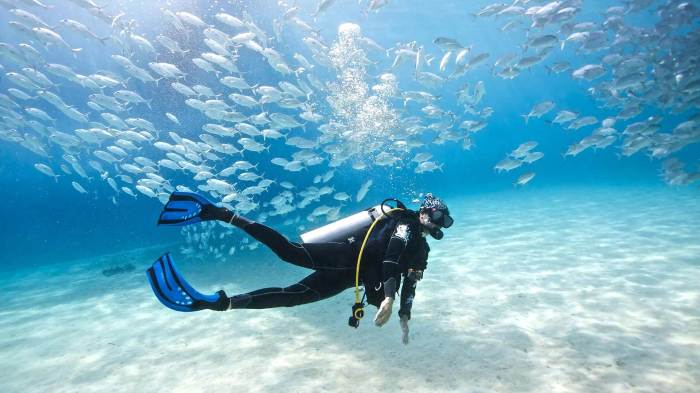
Scuba diving requires specialized equipment to ensure the safety and comfort of divers. Technological advancements have revolutionized the diving experience, enhancing safety and exploration capabilities.
Whether you’re an experienced diver or a novice looking to explore the underwater world with your family, consider visiting family-friendly resorts that offer scuba diving programs tailored to different skill levels. These resorts provide a safe and fun environment for families to bond and create lasting memories while exploring the vibrant marine life and breathtaking coral reefs.
Essential scuba diving equipment includes:
- Buoyancy Compensator Device (BCD): Controls buoyancy by adjusting the volume of air in the bladder, allowing divers to ascend, descend, and maintain neutral buoyancy.
- Scuba Tank: Stores compressed air or other breathing gas that supplies divers with oxygen underwater.
- Regulator: Reduces the high pressure of gas in the tank to a breathable pressure, delivering it to the diver’s mouth.
- Mask: Provides clear vision underwater and protects the eyes from water and debris.
- Fins: Propel divers through the water, increasing efficiency and reducing fatigue.
- Wetsuit or Drysuit: Provides thermal insulation and protection from the cold, allowing divers to extend their dive time and explore deeper waters.
- Dive Computer: Monitors dive parameters such as depth, time, ascent rate, and air consumption, enhancing safety and dive planning.
Latest Advancements in Scuba Diving Technology
Recent advancements in scuba diving technology have significantly improved the safety and enjoyment of diving. Some notable advancements include:
- Electronic Dive Logs: Record dive data digitally, providing detailed insights into dive profiles, gas consumption, and other parameters.
- Rebreathers: Recycle exhaled air, reducing gas consumption and extending dive times. Closed-circuit rebreathers provide longer dive durations and eliminate bubble noise, enhancing stealth and marine life encounters.
- Sidemount Diving: Configures tanks on the diver’s hips instead of the back, improving buoyancy control, streamlining, and reducing drag.
- Full-Face Masks: Integrate the regulator into the mask, providing a wider field of vision and reducing jaw fatigue.
- Air-Integrated Dive Computers: Wireless connection to the regulator provides real-time air pressure and consumption data, enhancing safety and gas management.
How Technology Enhances the Diving Experience
Technological advancements have transformed the diving experience in several ways:
- Increased Safety: Dive computers, electronic dive logs, and rebreathers provide valuable information and monitoring capabilities, reducing the risk of accidents.
- Extended Dive Times: Rebreathers and closed-circuit rebreathers significantly increase dive times, allowing divers to explore deeper and for longer durations.
- Improved Buoyancy Control: Sidemount diving and electronic dive computers provide precise buoyancy control, enhancing stability and reducing fatigue.
- Enhanced Visibility: Full-face masks offer a wider field of vision, improving situational awareness and enhancing marine life encounters.
- Reduced Physical Exertion: Sidemount diving and streamlined equipment reduce drag and physical exertion, making diving more enjoyable and accessible.
Tips for Choosing a Scuba Diving Location
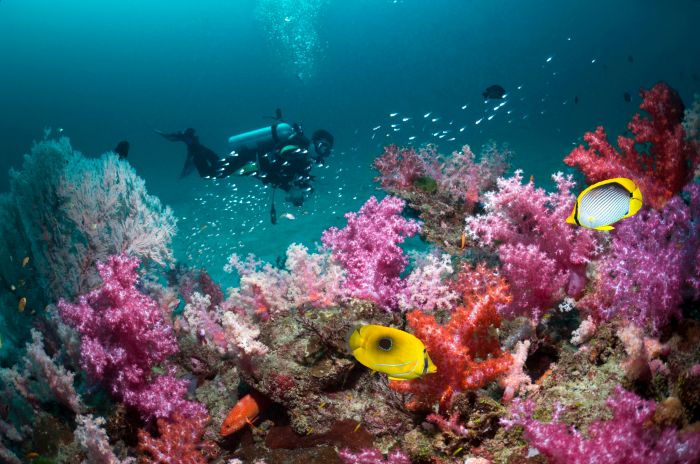
Selecting the ideal scuba diving location requires careful consideration of several key factors to ensure an enjoyable and memorable experience. Here’s a comprehensive guide to help you make an informed decision:
Skill Level and Experience
- Consider your current scuba diving skills and experience level.
- Choose destinations that align with your abilities and comfort level.
- For beginners, opt for locations with calm waters and shallow reefs.
- Advanced divers may seek more challenging sites with deeper dives and stronger currents.
Desired Marine Life Encounters
- Research the marine life found at different destinations.
- Identify specific species or ecosystems you’re eager to encounter.
- Consider destinations known for their abundance and diversity of marine life.
- Explore locations that offer unique encounters, such as swimming with whale sharks or manta rays.
Budget and Travel Logistics
- Determine your budget for travel, accommodation, and diving expenses.
- Consider the cost of flights, accommodation, food, and dive packages.
- Research travel logistics, including flight availability, visa requirements, and local transportation.
- Choose destinations that are accessible and within your financial means.
Seasonal Conditions, Scuba diving locations
- Research the seasonal conditions of potential destinations.
- Consider factors such as water temperature, visibility, and weather patterns.
- Choose locations that offer optimal conditions for diving during your travel period.
- Avoid destinations with strong currents or rough seas during certain seasons.
Conclusion
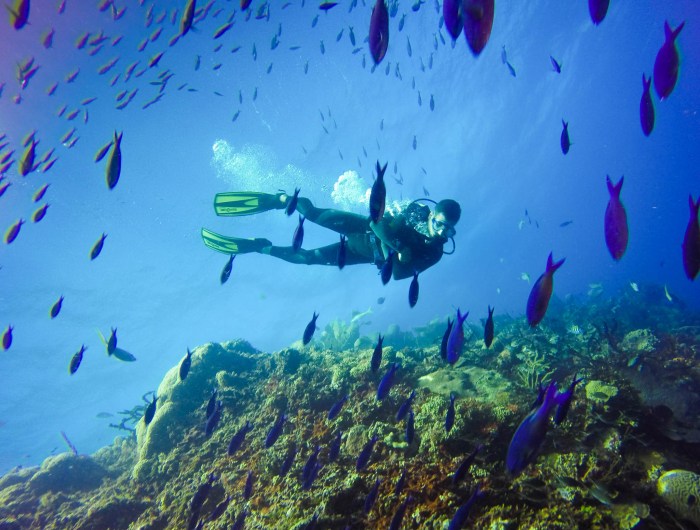
Scuba diving offers an unparalleled opportunity to explore the wonders of the underwater world. With its stunning marine life, vibrant coral reefs, and underwater adventures, scuba diving is an experience that will stay with you forever. Whether you are a beginner or an experienced diver, there is a scuba diving destination that is perfect for you.
So, what are you waiting for? Plan your next scuba diving adventure today and discover the incredible beauty that lies beneath the waves.
Last Word
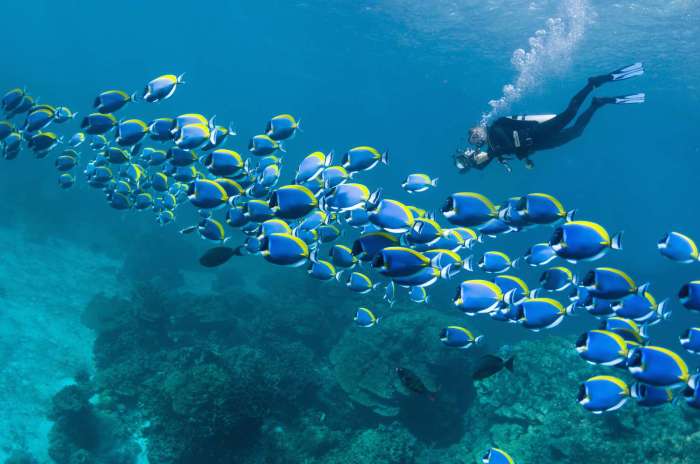
As you venture into the depths of the ocean, remember the importance of safety and environmental conservation. Embrace the transformative power of scuba diving, where every breath unveils a new wonder and fosters a deep appreciation for the delicate balance of marine ecosystems. May your next scuba diving adventure be filled with awe-inspiring encounters and cherished memories.
Top FAQs
What are the key factors to consider when choosing a scuba diving location?
Skill level, desired marine life encounters, budget, travel logistics, and seasonal conditions.
What are some of the most popular scuba diving destinations worldwide?
The Great Barrier Reef, Maldives, Galapagos Islands, Red Sea, and Raja Ampat.
What are the different types of scuba diving environments?
Coral reefs, shipwrecks, underwater caves, and open ocean.
What is the importance of protecting marine ecosystems?
To preserve biodiversity, support fisheries, regulate climate, and provide recreational opportunities.